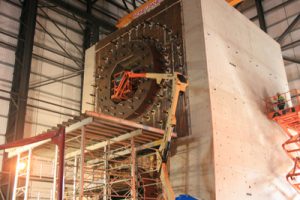Moog Industrial Group introduces its electric pitch control systems for controlling the angle of inclination of a wind turbine’s blades. Moog’s array of hardware, software and services also includes blade-sensing systems, rotor monitoring systems, slip rings and global training and services.
Moog has supplied more than 27,000 systems and products to many of the world’s top-ten wind turbine manufacturers. The company’s wind industry products and expertise span both electric and hydraulic technologies. Moog’s wind industry experts will explain how using the company’s systems on today’s wind turbines can reduce maintenance, improve safety and boost efficiency. For example, by precisely monitoring wind loads on blades, the rotor monitoring system improves the turbine’s life span and maintenance costs. Predictive maintenance is vital to wind park operators because the cost of a shutdown and subsequent turbine repairs is high.
Moog Pitch Systems also improve safety when the wind turbine loses electrical power. The pitch system puts the turbine blades off-wind into a safe operating mode that protects the wind turbine from damage. When the wind blows at 25 meters per second (50 mph) or higher, a wind turbine needs a failsafe to put its blades at an angle where the load is reduced and the wind turbine stops.
Found in the hub of the wind turbine, the Moog Pitch System consists of: control boxes containing Moog Pitch Servo Drives; Wind Pitch Servo Motors; and, a control system including software for remote diagnostics and back-up power.
Moog also offers slip ring solutions, which are critical to operation. Found inside the wind turbine’s nacelle, Moog’s slip rings provide electrical signals and energy for blade pitch power and control. Moog’s fiber brush slip rings offer wind turbine owners a minimum of 100 million revolutions of operational life with no maintenance.
Moog signed a contract to supply a test system to NAREC (National Renewable Energy Centre) to evaluate and test wind turbine blades at NAREC’s new 100-m (328-ft.) blade testing facility in Blyth, Northumberland, United Kingdom.
Opening this summer, turbine blade manufacturers will use NAREC to test prototype blade designs and manufacturing processes. The new facility will accommodate blades being designed for larger offshore wind turbines up to 100 m (328 ft.) in length and will complement NAREC’s existing capability testing blades in the 50-m (164 ft.) range.
The new 100-m (328 ft.) blade test facility will provide an independent and confidential environment to accelerate the development of new blade designs before they are taken offshore. It will be the largest facility of its type in the world and expands on NAREC’s existing blade-testing capability developed over the last five years, serving the global supply chain and industrial research communities.
Stuart Bibb, Market Manager, Moog Test Systems said, “Our division within Moog specializes
in structural testing for the aerospace industry. Using computer-controlled hydraulic technology, we are able to simulate service loads to ascertain structural strength prior to initial flight-testing. We were able to apply the same experience, technology and skills to NAREC’s requirements to deliver the right solution.”
Dean Goodwin, Mechanical Lead Engineer, at NAREC said, “NAREC undertakes fatigue testing of wind turbine blades using a hydraulic system to resonate the blade at its natural frequency. Moog’s track record in the aerospace industry provided us with the confidence in their solution for our new world-leading facility.”
Moog will supply and commission a Test Controller and monitoring system to control the NAREC Control Resonance Mass (CRM), which excites natural frequencies in the blade structure to evaluate the blades’ resistance to fatigue under representative dynamic loading conditions. The scope of supply will also include a very high flow PLC controlled Hydraulic Power Unit designed to interface with the NAREC primary control system.
The power unit, comprising six Moog RKP Radial Piston Pumps, has an installed power of 675 kW, delivering a flow of 1,200 lpm (317 gpm US) at a pressure of 280 bar (4061 psi). A dedicated PLC controls and monitors the performance and health of the unit and a water-cooling system maintains the temperature of the hydraulic fluid. High pressure hydraulic fluid is circulated around the facility by a custom designed distribution network.
For more information, visit www.moog.com.

























